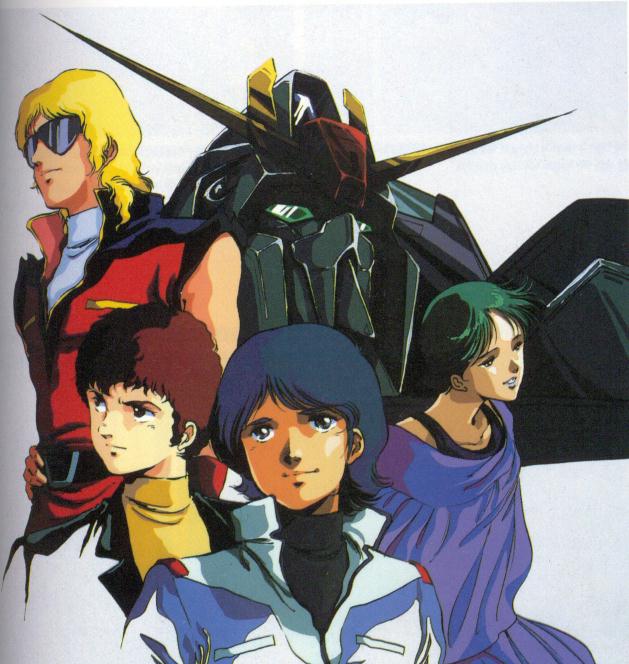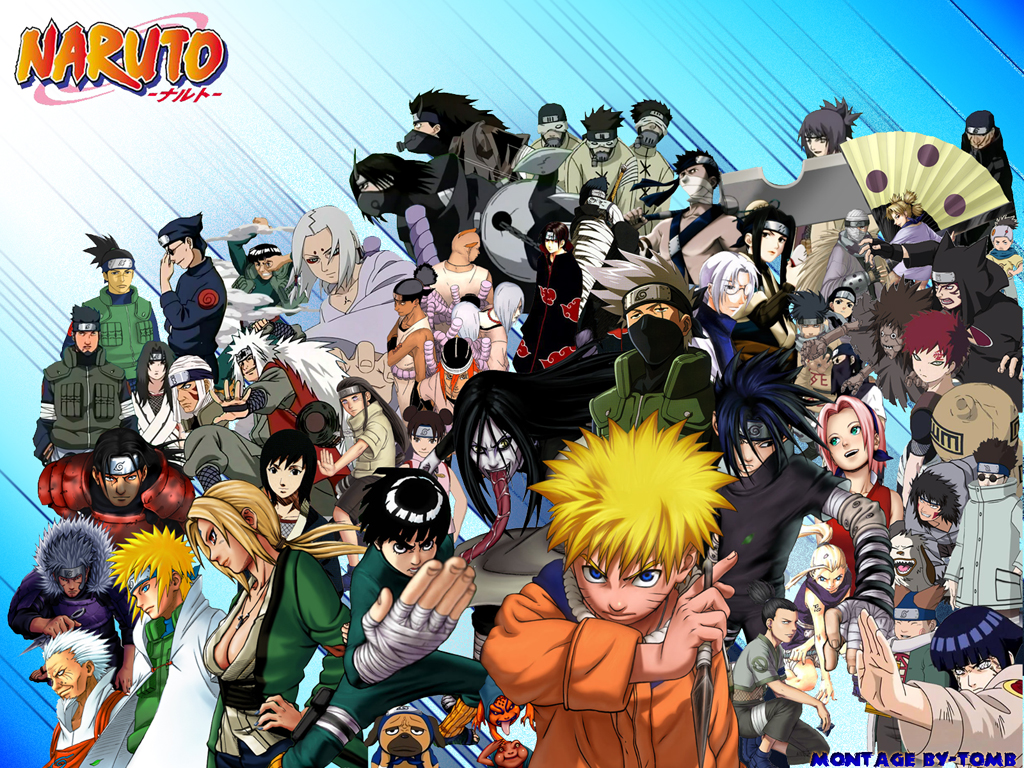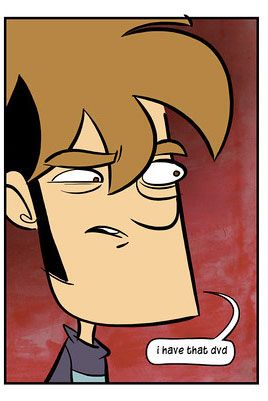Provocative title got your attention? Good! Read on, dear reader! Don't worry, this isn't a rant, it's an article. 
As tends to happen when people level distaste at something they have little actual experience with, there's a lot of misconceptions that are flat-out wrong. But it's not just the "haters" who are wrong. Oh no, the fans of the thing are very wrong too. So stand to the side over there, my fellow otaku, I'll be putting you guys though the grinder in a moment. What makes me qualified to say I'm right? A combination of close to 10 years of watching anime, over 440 different series, and having lived in Japan. I also read a lot. Feel free to disagree at your peril!
To be perfectly honest, much of this post will be directed at you guys. You guys who, from the rooftops of the internet cry "anime is for paedophiles!" "anime is weird!" "anime is all !" So let's begin with the very basics.
Chapter I: "Anime is all X!"
Let's get down to brass tacks, the number one accusation people level at anime is that it's all one particular thing. Be it angsty teens with spiky hair and massive swords, pedo bait, schoolgirls with huge eyes or tentacle porn, somehow anime is all the same thing, but that same thing is never the same thing. Well, to begin with: ANIME IS NOT A "GENRE". IT'S A "MEDIUM".
*EDIT* It seems a number of people have misinterpreted what I meant by this, probably because they didn't read any further. When I said "ANIME IS NOT A "GENRE". IT'S A "MEDIUM"", I don't mean that I think there's a special medium called "anime". What I was implying is that it's simply part of the medium of "animation", something I thought I made clear a few paragraphs down when I said "They're both part of the "medium" of animation!"
For those unfamiliar with the difference, here's the dictionary definition of the two:

Bartender
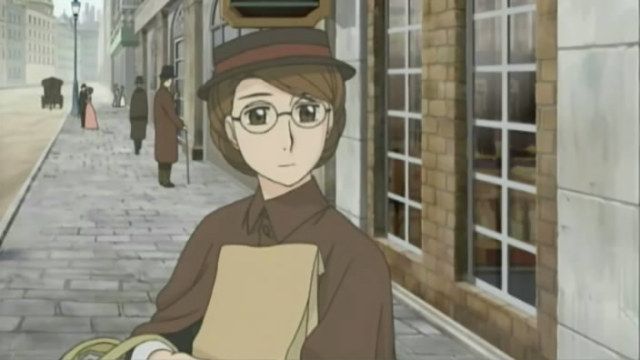
Victorian Romance Emma
The first is a drama series about a talented young bartender, who helps his customers with their problems by serving them a particular cocktail, explains the history of the drink and how it relates to the customer's situation. The second is a romance set in Victorian London about the forbidden relationship between the son of a noble family and a maid.
Are the form, content or technique between these two series similar? No? Ah! But there's one area in which they are. The materials and methods of production used. They're both part of the "medium" of animation! Basically, saying that all anime are the same, would be like saying all American movies are about cars and explosions based on the fact you've seen Michael Bay's Transformers. Which is an incredible disservice to all the other films that are not Transformers and are nothing like Transformers.
Anime can be about anything, and often is about anything. Everything from coming-of-age dramas set in art collage (Honey and Clover), philosophy on culture and society (Kino's Journey), comedies about university clubs (Genshiken), immortal mobsters in Prohibition-era America (Baccano!), hard science-fiction about the future of space-based occupations (Planetes) to anime about making anime (Animation Runner Kuromi-chan. "Yo dawg we heard you like anime..."). Even themes that we consider traditional here in the West are represented. Vampires (Hellsing), romantic comedies (Lovely Complex), 80s style action (Gunsmith Cats), zombies (High School of the Dead), war (Grave of the Fireflies) and murder-mystery (Monster) are all here.
Chapter II: "All Anime Look the Same!"
Let's play a quick game shall we? I'm going to post five images from five different animations. I want you to identify which country they're from, (I'm assuming you don't actually recognise them). Ready? GO!
 A) America
A) America
B) France
C) Japan
E) Eastern Europe
 A) America
A) America
B) France
C) Japan
E) Eastern Europe
 A) America
A) America
B) France
C) Japan
E) Eastern Europe
 A) America
A) America
B) France
C) Japan
E) Eastern Europe
 A) America
A) America
B) France
C) Japan
E) Eastern Europe
All done? If you answered anything other than "C) Japan", you're wrong. All these images are from Japanese animations (La Maison en Petits Cubes, Panty & Stocking with Garterbelt, FLAG, Tekkonkinkreet and Sailor Moon respectively). So why does only the last one look like what most people think of as "anime"?
As I've already said, anime isn't a "genre" and this extends to the art too. The director can have whatever kind of art style he wants to use, and so long as it's animation from Japan, made for a Japanese audience, it's still "anime".
However, the vast majority of anime do indeed share a similar art style, owing to a combination of "it provides a good balance between looking good while not being expensive to animate" and "people expect it to look like this". However, the common art style people think of is stuck firmly somewhere in 1993. Here's more what I consider the modern "common" anime style to look like:

K-ON!
Of note are the realistic hair colors and body proportions (real Japanese girls have short, chubby legs like the K-ON! girls). The eyes, while still larger than real humans (you can thank Disney for this, he found that giving characters larger eyes makes them cuter and more expressive, something which Japanese animators copied) are not as absurdly large as the 90s style. The overall look is also "softer" and not as "harsh" as older anime, probably due to modern anime being done on computers with digital effects instead of on cells.
Even among anime that have a similar look, there will usually be a little something that gives a particular series it's own distinct flair. For example:

House of Five Leaves with it's unique facial designs

Working!! with it's distinctive "gradient" hair colors
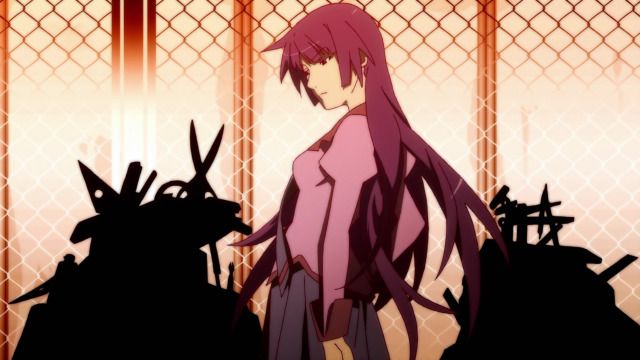
Bakemonogatari with it's... Everything.
And these are just a few examples of the many anime out there like this. So anyway, I've talked about you guys long enough, time to give the otaku a good grilling!
Ah, my fellow Japanese animation fan! Did you know that everything you know about anime is wrong? Here's why!
Chapter I: Everyone in Japan Watches and Loves Anime!
Do you know what the top three highest-ranked animated programs in Japan were for December 26th to January 1st were? Doraemon, Tamagotchi! and Shaun the Sheep. All family-oriented shows, one of which isn't even Japanese. Sazae-san usually ranks pretty high up too. "Sazae who?" I hear you say? Sazae-san, it's an animated series that's been airing since 1969 and has over 3000 episodes, surely you've heard of it? No? About the closest thing we have to what fans would call "anime" is Naruto Shippuden all the way in 9th place.

Sazae-san, a popular, long-running "anime"
You know how people on the interent tease you about being a weird closet paedophile for watching anime? Yeah, that totally happens in Japan too. Here's the thing, while Japan does indeed treat animation much better than the West does [http://tvtropes.org/pmwiki/pmwiki.php/Main/AnimationAgeGhetto], the vast majority of it is watched by, and created for, the fans. People who the average person sees represented in the media as fat creeps who take up-skirt photos of strangers and murder and eat little girls [http://en.wikipedia.org/wiki/Tsutomu_Miyazaki]. Also, the word "otaku" has a LOT of negative connotations in Japan, so you really shouldn't identify yourself with it.
In fact, one of the big issues in the Japanese animation industry has been expanding their audience beyond the typical young male demographic. The "noitaminA" (read it backwards ) programming block was created with this very purpose, and airs shows like Hataraki Man, The Tatami Galaxy and Princess Jellyfish, unique shows that they hope will catch a new audience, and pretty much why I love basically everything they air so damned much. Tiger & Bunny was another recent show that was created with the intent of appealing to a new audience. They managed to capture a sizable female audience, but it didn't quite work out as they had planned. Last I heard, they were planning a live-action version, which I expect will be a more successful endeavour.
) programming block was created with this very purpose, and airs shows like Hataraki Man, The Tatami Galaxy and Princess Jellyfish, unique shows that they hope will catch a new audience, and pretty much why I love basically everything they air so damned much. Tiger & Bunny was another recent show that was created with the intent of appealing to a new audience. They managed to capture a sizable female audience, but it didn't quite work out as they had planned. Last I heard, they were planning a live-action version, which I expect will be a more successful endeavour.

Princess Jellyfish, an anime that appeared on the "noitaminA" block intended to appeal beyond the typical demographic of young males
Now, if you're talking about manga (comic books), then yes, nearly everyone in Japan reads and loves manga. It's very common to see old men on the trains reading some kinda manga, and the father of the family I stayed with in Japan was a big fan of "The Golden Rough" a golf manga. Why the big discrepancy between two mediums that are very similar? Well, think back to when video games first hit the scene. They were prominently played by kids right? Adult-orientated titles were very rare. Fast-forward to 2012, and video games have hit the mainstream, thanks to not only titles that have more appeal to a mainstream audience, but also to the gradual acceptance of video games as something that everyone can enjoy. Manga in Japan is like where video games are today, people have grown up reading them, there's plenty of titles that appeal to a mainstream audience, an audience that has also accepted manga as a medium. Anime on the other hand is in the 32-bit era, there's a number of great titles aimed at a mature audience, but society still sees them as "stuff for kids" or "nerd stuff".
Chapter II: Anime Is Better than American Cartoons!
"AH! HA! HA! HA! Oh wait, you're serious? Let me laugh even harder." That's a quote from Futurama in case you avoid all American animation altogether. Actually, I'm not even sure how relevant this point is these days. It used to be that new bloods would go though a "zomg! anime is awesome, American cartoons suck and are for babies!" stage, but with the way that the internet has vilified anime, I suspect there's no new bloods any more. Anyway, let's briefly address it.
American-made animation and Japanese-made animation are just that: animation. There's nothing that restricts how "good" each can be. Granted, the biggest strike against American produced animation is the "Animation Age Ghetto [http://tvtropes.org/pmwiki/pmwiki.php/Main/AnimationAgeGhetto]", where animation is perceived as "stuff for kids" by the general public and no one wants to make more "mature" animation. This is largely thanks to what Hanna-Barbera did in the 60s (a story for another time), but the effects are still being felt today. Where's the American answer to Death Note? To Monster? At least, that's the more mainstream stuff I'm talking about here, no disrespect intended towards the wonderfully-talented Don Hertzfeldt.
Thankfully, things are changing, shows like The Simpsons, Family Guy and American Dad! are changing the perception that animation is just for kids, but at the same time, it's almost like they're moving from one ghetto to another. Notice all these shows are comedies? About the only American animation I can think of with more of a "serious" slant is The Boondocks. And Boondocks creator Aaron McGruder is a fan of anime, did this give him the courage to make an animated show that also dealt with more mature subjects?
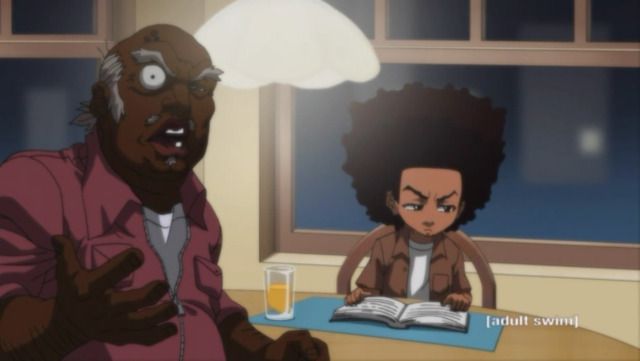
The Boondocks, American animation with a Japanese flavour
In terms of technical merit, it's largely budget-related. Traditional American animation favours a higher framerate for smoother animation, but unless you've got a Disney-size budget, the drawings must be kept simple and dispense with things like shading and intricate character costumes. Even then, this style of animation is still quite expensive, with The Simpsons allegedly costing $2 million per episode. For Japanese animation, even a series with a good budget like Full Metal Alchemist allegedly only cost $5.6 million. FOR THE ENTIRE SERIES. Advertising budget included. Clearly, a Simpsons level budget is out of the question, it needs to get made cheap or not at all. That's where the tactic of more detailed drawings at the expense of a lower framerate comes in. Despite the lower framerate, the show still looks good, thanks to more detailed artwork, and the lower framerate means it's cheaper to produce. But in either case, give an American animation studio a high budget, or give a Japanese animation studio a high budget, and in both cases, you will get high-quality animation.
So in closing, there's a lot people who are wrong when it comes to Japanese animation. People who don't watch it are wrong, people who do watch it are wrong. But in the end, the important thing we must not forget is this: I'm right. Oh, and everyone had misconceptions and you should keep your mind open to the possibility of etc ect ect blah blah blah. Hope you enjoyed the article! And I also hope you learned something from it!
*EDIT* Added clarification about my stance on ANIME IS NOT A "GENRE". IT'S A "MEDIUM"
*EDIT* Changed the first example from Serial Experiments Lain to Bartender. Upon reflection, it was not the best image to open with, what with first impressions and all. I was hoping the internet could be mature about it, but apparently not. Also, you should totally watch Serial Experiments Lain, it's an excellent show.
Everything You Know about Anime Is Wrong
Japanese animation ("anime") and the internet have a strange relationship. There was once a time (late 90s, early 2000s to be precise) where if you liked video games, and hung out on the internet, you generally liked anime too. Now, it seems like anime has somehow replaced furries as the internet's favourite punching bag. But this is a subject for a whole other time, so let's keep moving along shall we? As tends to happen when people level distaste at something they have little actual experience with, there's a lot of misconceptions that are flat-out wrong. But it's not just the "haters" who are wrong. Oh no, the fans of the thing are very wrong too. So stand to the side over there, my fellow otaku, I'll be putting you guys though the grinder in a moment. What makes me qualified to say I'm right? A combination of close to 10 years of watching anime, over 440 different series, and having lived in Japan. I also read a lot. Feel free to disagree at your peril!
Part One: The Those Who Profess Disgust for Something They Have No Experience With (A.K.A "Haters")
To be perfectly honest, much of this post will be directed at you guys. You guys who, from the rooftops of the internet cry "anime is for paedophiles!" "anime is weird!" "anime is all !" So let's begin with the very basics.
Chapter I: "Anime is all X!"
Let's get down to brass tacks, the number one accusation people level at anime is that it's all one particular thing. Be it angsty teens with spiky hair and massive swords, pedo bait, schoolgirls with huge eyes or tentacle porn, somehow anime is all the same thing, but that same thing is never the same thing. Well, to begin with: ANIME IS NOT A "GENRE". IT'S A "MEDIUM".
*EDIT* It seems a number of people have misinterpreted what I meant by this, probably because they didn't read any further. When I said "ANIME IS NOT A "GENRE". IT'S A "MEDIUM"", I don't mean that I think there's a special medium called "anime". What I was implying is that it's simply part of the medium of "animation", something I thought I made clear a few paragraphs down when I said "They're both part of the "medium" of animation!"
For those unfamiliar with the difference, here's the dictionary definition of the two:
Genre: A class or category of artistic endeavour having a particular form, content, technique, or the like
What makes Japanese animation a "medium" and not a "genre"? Simple! A genre requires the content and themes of a work to be similar, while the content and themes between two anime can be radically different. For example, let's compare Bartender to Victorian Romance EmmaMedium: The category of a work of art, as determined by its materials and methods of production

Bartender

Victorian Romance Emma
The first is a drama series about a talented young bartender, who helps his customers with their problems by serving them a particular cocktail, explains the history of the drink and how it relates to the customer's situation. The second is a romance set in Victorian London about the forbidden relationship between the son of a noble family and a maid.
Are the form, content or technique between these two series similar? No? Ah! But there's one area in which they are. The materials and methods of production used. They're both part of the "medium" of animation! Basically, saying that all anime are the same, would be like saying all American movies are about cars and explosions based on the fact you've seen Michael Bay's Transformers. Which is an incredible disservice to all the other films that are not Transformers and are nothing like Transformers.
Anime can be about anything, and often is about anything. Everything from coming-of-age dramas set in art collage (Honey and Clover), philosophy on culture and society (Kino's Journey), comedies about university clubs (Genshiken), immortal mobsters in Prohibition-era America (Baccano!), hard science-fiction about the future of space-based occupations (Planetes) to anime about making anime (Animation Runner Kuromi-chan. "Yo dawg we heard you like anime..."). Even themes that we consider traditional here in the West are represented. Vampires (Hellsing), romantic comedies (Lovely Complex), 80s style action (Gunsmith Cats), zombies (High School of the Dead), war (Grave of the Fireflies) and murder-mystery (Monster) are all here.
Chapter II: "All Anime Look the Same!"
Let's play a quick game shall we? I'm going to post five images from five different animations. I want you to identify which country they're from, (I'm assuming you don't actually recognise them). Ready? GO!

B) France
C) Japan
E) Eastern Europe

B) France
C) Japan
E) Eastern Europe

B) France
C) Japan
E) Eastern Europe

B) France
C) Japan
E) Eastern Europe

B) France
C) Japan
E) Eastern Europe
All done? If you answered anything other than "C) Japan", you're wrong. All these images are from Japanese animations (La Maison en Petits Cubes, Panty & Stocking with Garterbelt, FLAG, Tekkonkinkreet and Sailor Moon respectively). So why does only the last one look like what most people think of as "anime"?
As I've already said, anime isn't a "genre" and this extends to the art too. The director can have whatever kind of art style he wants to use, and so long as it's animation from Japan, made for a Japanese audience, it's still "anime".
However, the vast majority of anime do indeed share a similar art style, owing to a combination of "it provides a good balance between looking good while not being expensive to animate" and "people expect it to look like this". However, the common art style people think of is stuck firmly somewhere in 1993. Here's more what I consider the modern "common" anime style to look like:

K-ON!
Of note are the realistic hair colors and body proportions (real Japanese girls have short, chubby legs like the K-ON! girls). The eyes, while still larger than real humans (you can thank Disney for this, he found that giving characters larger eyes makes them cuter and more expressive, something which Japanese animators copied) are not as absurdly large as the 90s style. The overall look is also "softer" and not as "harsh" as older anime, probably due to modern anime being done on computers with digital effects instead of on cells.
Even among anime that have a similar look, there will usually be a little something that gives a particular series it's own distinct flair. For example:

House of Five Leaves with it's unique facial designs

Working!! with it's distinctive "gradient" hair colors

Bakemonogatari with it's... Everything.
And these are just a few examples of the many anime out there like this. So anyway, I've talked about you guys long enough, time to give the otaku a good grilling!
Part Two: Tough Love for the Otaku
Ah, my fellow Japanese animation fan! Did you know that everything you know about anime is wrong? Here's why!
Chapter I: Everyone in Japan Watches and Loves Anime!
Do you know what the top three highest-ranked animated programs in Japan were for December 26th to January 1st were? Doraemon, Tamagotchi! and Shaun the Sheep. All family-oriented shows, one of which isn't even Japanese. Sazae-san usually ranks pretty high up too. "Sazae who?" I hear you say? Sazae-san, it's an animated series that's been airing since 1969 and has over 3000 episodes, surely you've heard of it? No? About the closest thing we have to what fans would call "anime" is Naruto Shippuden all the way in 9th place.

Sazae-san, a popular, long-running "anime"
You know how people on the interent tease you about being a weird closet paedophile for watching anime? Yeah, that totally happens in Japan too. Here's the thing, while Japan does indeed treat animation much better than the West does [http://tvtropes.org/pmwiki/pmwiki.php/Main/AnimationAgeGhetto], the vast majority of it is watched by, and created for, the fans. People who the average person sees represented in the media as fat creeps who take up-skirt photos of strangers and murder and eat little girls [http://en.wikipedia.org/wiki/Tsutomu_Miyazaki]. Also, the word "otaku" has a LOT of negative connotations in Japan, so you really shouldn't identify yourself with it.
In fact, one of the big issues in the Japanese animation industry has been expanding their audience beyond the typical young male demographic. The "noitaminA" (read it backwards

Princess Jellyfish, an anime that appeared on the "noitaminA" block intended to appeal beyond the typical demographic of young males
Now, if you're talking about manga (comic books), then yes, nearly everyone in Japan reads and loves manga. It's very common to see old men on the trains reading some kinda manga, and the father of the family I stayed with in Japan was a big fan of "The Golden Rough" a golf manga. Why the big discrepancy between two mediums that are very similar? Well, think back to when video games first hit the scene. They were prominently played by kids right? Adult-orientated titles were very rare. Fast-forward to 2012, and video games have hit the mainstream, thanks to not only titles that have more appeal to a mainstream audience, but also to the gradual acceptance of video games as something that everyone can enjoy. Manga in Japan is like where video games are today, people have grown up reading them, there's plenty of titles that appeal to a mainstream audience, an audience that has also accepted manga as a medium. Anime on the other hand is in the 32-bit era, there's a number of great titles aimed at a mature audience, but society still sees them as "stuff for kids" or "nerd stuff".
Chapter II: Anime Is Better than American Cartoons!
"AH! HA! HA! HA! Oh wait, you're serious? Let me laugh even harder." That's a quote from Futurama in case you avoid all American animation altogether. Actually, I'm not even sure how relevant this point is these days. It used to be that new bloods would go though a "zomg! anime is awesome, American cartoons suck and are for babies!" stage, but with the way that the internet has vilified anime, I suspect there's no new bloods any more. Anyway, let's briefly address it.
American-made animation and Japanese-made animation are just that: animation. There's nothing that restricts how "good" each can be. Granted, the biggest strike against American produced animation is the "Animation Age Ghetto [http://tvtropes.org/pmwiki/pmwiki.php/Main/AnimationAgeGhetto]", where animation is perceived as "stuff for kids" by the general public and no one wants to make more "mature" animation. This is largely thanks to what Hanna-Barbera did in the 60s (a story for another time), but the effects are still being felt today. Where's the American answer to Death Note? To Monster? At least, that's the more mainstream stuff I'm talking about here, no disrespect intended towards the wonderfully-talented Don Hertzfeldt.
Thankfully, things are changing, shows like The Simpsons, Family Guy and American Dad! are changing the perception that animation is just for kids, but at the same time, it's almost like they're moving from one ghetto to another. Notice all these shows are comedies? About the only American animation I can think of with more of a "serious" slant is The Boondocks. And Boondocks creator Aaron McGruder is a fan of anime, did this give him the courage to make an animated show that also dealt with more mature subjects?

The Boondocks, American animation with a Japanese flavour
In terms of technical merit, it's largely budget-related. Traditional American animation favours a higher framerate for smoother animation, but unless you've got a Disney-size budget, the drawings must be kept simple and dispense with things like shading and intricate character costumes. Even then, this style of animation is still quite expensive, with The Simpsons allegedly costing $2 million per episode. For Japanese animation, even a series with a good budget like Full Metal Alchemist allegedly only cost $5.6 million. FOR THE ENTIRE SERIES. Advertising budget included. Clearly, a Simpsons level budget is out of the question, it needs to get made cheap or not at all. That's where the tactic of more detailed drawings at the expense of a lower framerate comes in. Despite the lower framerate, the show still looks good, thanks to more detailed artwork, and the lower framerate means it's cheaper to produce. But in either case, give an American animation studio a high budget, or give a Japanese animation studio a high budget, and in both cases, you will get high-quality animation.
So in closing, there's a lot people who are wrong when it comes to Japanese animation. People who don't watch it are wrong, people who do watch it are wrong. But in the end, the important thing we must not forget is this: I'm right. Oh, and everyone had misconceptions and you should keep your mind open to the possibility of etc ect ect blah blah blah. Hope you enjoyed the article! And I also hope you learned something from it!
*EDIT* Added clarification about my stance on ANIME IS NOT A "GENRE". IT'S A "MEDIUM"
*EDIT* Changed the first example from Serial Experiments Lain to Bartender. Upon reflection, it was not the best image to open with, what with first impressions and all. I was hoping the internet could be mature about it, but apparently not. Also, you should totally watch Serial Experiments Lain, it's an excellent show.




